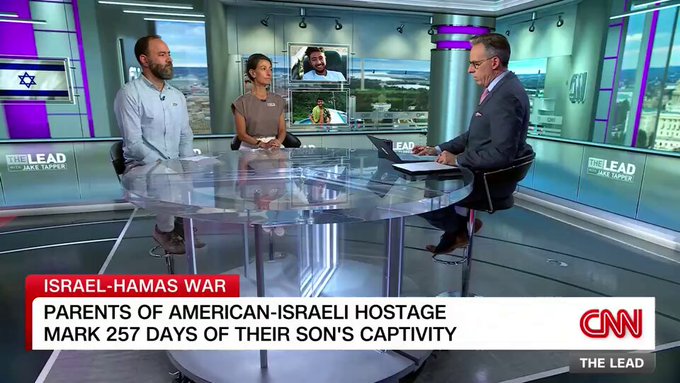
 Brak zainteresowania amerykańskich mediów sprawą amerykańskich zakładników, jak również mediów 23 innych krajów, których obywatele też są zakładnikami w Gazie
Brak zainteresowania amerykańskich mediów sprawą amerykańskich zakładników, jak również mediów 23 innych krajów, których obywatele też są zakładnikami w Gazie
Daled Amos
Tłumaczenie: Małgorzata Koraszewska
Tapper: Jest coś, nad czym zawsze się zastanawiałem przez cały ten proces od 7 października: jest ośmiu zakładników z podwójnym obywatelstwem amerykańsko-izraelskim, w tym twój syn. Uważa się, że pięciu z nich, w tym twój syn, żyje. Trzej z nich nie. Czy jesteście zaskoczeni, że w amerykańskich mediach i wśród amerykańskich polityków nie mówi się więcej o fakcie, że grupa terrorystyczna przetrzymuje w Gazie pięciu prawdopodobnie żyjących amerykańskich zakładników?
Rachel Goldberg-Polin: Zdecydowanie uważam, że to szokujące, że olbrzymia większość Amerykanów nie ma pojęcia, że obecnie, kiedy teraz rozmawiamy, ośmiu obywateli USA jest przetrzymywanych jako zakładnicy w Gazie. Czuję to tak mocno, pamiętam, kiedy Brittney Griner była niesprawiedliwie przetrzymywana. I oczywiście Evan Gershkovich, który nadal przebywa w areszcie. Dla mnie to nazwiska dobrze znane. Zdecydowana większość Amerykanów nie ma pojęcia, że tych ośmiu obywateli USA jest przetrzymywanych. To już 257 dni i uważam, że to po prostu jest szokujące.
Pani Goldberg-Polin nie wyjaśnia obojętności mediów w USA wobec amerykańskich zakładników w Gazie. Taka apatia przypomina nam podobny brak entuzjazmu, jaki wykazują amerykańskie media w przypadku relacjonowania historii Ahlam Tamimi, sprawczyni masakry w Sbarro, która żyje jako gwiazda medialna w Jordanii, gdzie król Abdullah odmawia przestrzegania postanowień traktatu ekstradycyjnego nakazującego przekazanie Tamimi do USA, by stanęła tam przed sądem.
Media zdradzają swoją odpowiedzialność za relacjonowanie ważnych historii mających wpływ na życie obywateli amerykańskich, co powoduje ignorancję, jaką widzimy na temat tego, co się dzieje, i podważa popularne poparcie USA dla ratowania zakładników i radzenia sobie z zagrożeniem ze strony terrorystów Hamasu.
Jak jednak wynika z wywiadu, kraje, których obywatele zostali porwani, są nie mniej apatyczne:
Rachel Goldberg-Poline: Ludzie też nie są świadomi, że wśród 120 pozostałych zakładników są przedstawiciele 24 różnych narodów. Są to chrześcijanie, żydzi, muzułmanie, hinduiści i buddyści. Bardzo rzadko słyszę, jak ktoś występuje w obronie przetrzymywanych muzułmańskich Arabów, przetrzymywanych tajskich buddystów lub przetrzymywanych czarnych afrykańskich chrześcijan. Są tam Nepalczycy, Argentyńczycy, Niemcy, Polacy – po prostu o tym nie słychać. Próbują i nie wiem, kim są „oni”, ale świat próbuje stworzyć tę monolityczną, jednorodną grupę ludzi, co jest absolutną krzywdą i niesprawiedliwością wobec przetrzymywanych ludzi.
Jak często słyszymy, że zakładnicy pochodzą z 24 różnych krajów, a nie tylko z Izraela? Co jest przyczyną ich apatii?
Oto 24 kraje, poza Izraelem, których obywatele są przetrzymywani w niewoli:
o Argentyna
o Austria
o Brazylia
o Bułgaria
o Kanada
o Kolumbia
o Dania
o Francja
o Niemcy
o Węgry
o Włochy
o Meksyk
o Holandia
o Paragwaj
o Filipiny
o Polska
o Portugalia
o Rumunia
o Rosja
o Serbia
o Hiszpania
o Tajlandia
o Wielka Brytania
o Stany Zjednoczone
Można było spodziewać się zjednoczonego, publicznego oburzenia.
Właściwie był jeden przypadek z kwietnia: Stany Zjednoczone i 17 innych krajów mających zakładników w Gazie wzywały do ich uwolnienia w zamian za zawieszenie broni
Administracja Bidena opublikowała apel przywódców 18 krajów, których obywatele są zakładnikami w Gazie, wzywający do ich natychmiastowego uwolnienia w zamian za „natychmiastowe i długotrwałe zawieszenie broni”, które doprowadzi do „zakończenia działań wojennych”.
Dziwne jest to, że złożenie publicznego oświadczenia zajęło krajom mającym tak wspólny interes w ratowaniu swoich obywateli sześć i pół miesiąca.
Kolejną dziwną rzeczą jest to, że niektóre kraje nie mogły zmusić się do przyłączenia się do tego publicznego oświadczenia. Nie wymienione na liście krajów uczestniczących:o Włochy
o Meksyk
o Holandia
o Paragwaj
o Filipiny
o Rosja
o Włochy
Oto tekst oświadczenia ze strony internetowej Białego Domu:
Wzywamy do natychmiastowego uwolnienia wszystkich zakładników przetrzymywanych przez Hamas i Gazę od ponad 200 dni. Wśród nich są nasi obywatele. Los zakładników i ludności cywilnej w Gazie, chronionych na mocy prawa międzynarodowego, budzi zaniepokojenie międzynarodowe.
Podkreślamy, że rozpatrywane porozumienie w sprawie uwolnienia zakładników doprowadziłoby do natychmiastowego i długotrwałego zawieszenia broni w Gazie, co ułatwiłoby przypływ dodatkowej niezbędnej pomocy humanitarnej w całej Gazie i doprowadziłoby do wiarygodnego zakończenia działań wojennych. Gazańczycy będą mogli wrócić do swoich domów i na swoje ziemie po wcześniejszym przygotowaniu schronienia i pomocy humanitarnej.
Zdecydowanie wspieramy trwające wysiłki mediacyjne mające na celu „sprowadzenie naszych ludzi do domu”. Ponawiamy nasz apel do Hamasu o uwolnienie zakładników i zakończmy ten kryzys, abyśmy wspólnie mogli skoncentrować nasze wysiłki na zapewnieniu pokoju i stabilności w regionie” – podsumowano w oświadczeniu.
Dlaczego 6 krajów odmówiło podpisania?
Jedną z wskazówek może być sposób, w jaki Israel National News donosiły o tym oświadczeniu w podtytule:
Stany Zjednoczone i 16 innych krajów, których obywatele zostali porwani przez Hamas, wydały wspólne oświadczenie, w którym obwiniają Hamas za przedłużanie wojny przez odmowę uwolnienia zakładników.
Przyjrzyj się jeszcze raz oświadczeniu.
Widzisz, czego brakuje?
Nie ma wzmianki o Izraelu.
Israel National News mają rację. Składając całkowicie ciężar uwolnienia zakładników na Hamas, oświadczenie to obciąża Hamas całkowitą odpowiedzialnością. Jest to sprzeczne z linią partyjną, zgodnie z którą Izrael musi najpierw zaakceptować przedłużone zawieszenie broni w wojnie z Hamasem.
Jednak kraje, które podpisały się pod oświadczeniem, nawet nie żądają uwolnienia wszystkich zakładników:
Przedstawione porozumienie, które doprowadziłoby do zawieszenia broni w Gazie po prostu poprzez uwolnienie kobiet, rannych, osób starszych i chorych zakładników, jest gotowe do wdrożenia, powiedział wysoki rangą urzędnik administracji, a Hamas go odrzucił.
Krajom tym zajęło pół roku zebranie się i wydanie wspólnego oświadczenia, a nie potrafią one nawet żądać uwolnienia wszystkich swoich obywateli.
Nie należy się spodziewać żadnego przejawu jedności w ONZ w jakiejś rezolucji Zgromadzenia Ogólnego wzywającej do bezwarunkowego uwolnienia zakładników. Takie moralne potępienie naruszenia prawa międzynarodowego i przyzwoitości moralnej wyraźnie wykracza poza możliwości Organizacji Narodów Zjednoczonych.
Nic dziwnego, że Hamas ma wrażenie, że może się utrzymać w nieskończoność.
Daled Amos (Bennet Ruda) – Izraelski bloger piszący o historii i problemach Bliskiego Wschodu, a w szczególności Izraela. http://daledamos.blogspot.com/
Zawartość publikowanych artykułów i materiałów nie reprezentuje poglądów ani opinii Reunion’68,
ani też webmastera Blogu Reunion’68, chyba ze jest to wyraźnie zaznaczone.
Twoje uwagi, linki, własne artykuły lub wiadomości prześlij na adres:
webmaster@reunion68.com





